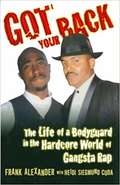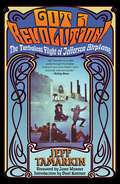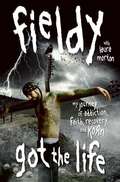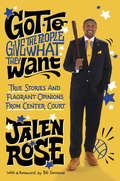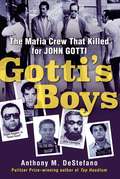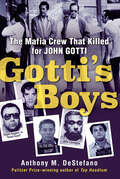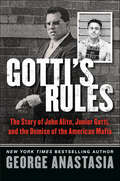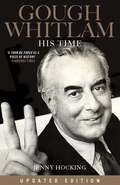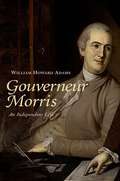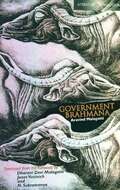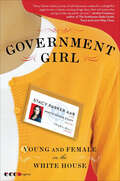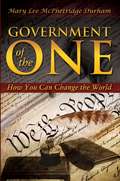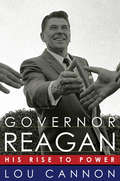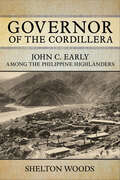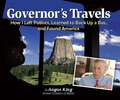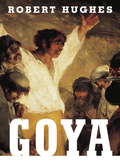- Table View
- List View
Gossip Boys: The double unauthorised biography of Ed Westwick and Chace Crawford
by Liz KayeOMG. It's Chuck Bass and Nate Archibald from Gossip Girl in one book. We're all mad about the boys, but is it Ed Westwick's bad-guy allure that ticks your box, or Chace Crawford's pretty-boy looks? Or - naughty - both? Well, to help you decide, Gossip Boys, the unauthorised double biography of Chace and Ed, charts the lives of these hot young things, who are best friends both on the show and in real life. Brit-born Westwick has the edgy cool of his character, having fronted the indie band The Filthy Youth, and appearing in cult films such as Son of Rambow and Children of Men. Crawford meanwhile is the ultimate all-American idol, signed by the first talent agent who interviewed him and being named 'Summer's Hottest Bachelor' by People and winning the Teen Choice Award for 'Male Hottie'. The huge success of Gossip Girl has seen these actors become two of the biggest pin-ups around, and favourites of magazines like Grazia and teen TV programming such as T4. Now you can learn all about the boys: their early days, their flames old and new, their careers and the bromance that has made them scorching stars.
Gosto de gostar
by Helena Sacadura CabralUm livro sobre o acto generoso de "gostar de gostar" e como ele nos preenche a vida. «Gosto de gostar dos meus filhos, gosto de gostar dos meus amigos, gosto de gostar do meu trabalho, até gosto de gostar de mim. Enfim, "gostar de gostar" é, de facto, muito mais do que gostar.» Sol numa manhã de Outono, o cheiro a alfazema das gavetas das nossas avós, uma tarde entre amigos, o calor da família. Pessoas, lugares, canções, perfumes, recordações: são inúmeras as coisas de que gostamos de gostar e que tornam as nossas vidas mais plenas. É de como "gostar de gostar" preenche a nossa vida que Helena Sacadura Cabral fala nestas páginas.
Got Here As Soon As I Could: Discovering the Way Life Should Be
by Sarah SmileyI&’m not from Maine… but I got here as soon as I could. Six years ago, a family from Florida fell in love with &“the way life should be,&” and althoughthey&’ve never seen a moose, the Smileys intend to stay. Because say what you will about the coldwinters and the messy mud season, there is no other place to raise a kid than in the great state ofMaine.Got Here As Soon As I Could is a collection of syndicated columnist Sarah Smiley&’smost-loved columns about raising a family in Maine. In these 100 essays, readers will laugh, cryand nod their head &“yes&” as they remember a time when all of America was as simple and beautiful as it still is today in Vacationland.
Got Your Back: Protecting Tupac in the World of Gangsta Rap
by Heidi Cuda Frank AlexanderOn September 13, 1996, Tupac Shakur was shot and killed in Las Vegas. Millions of fans wept, while many critics claimed it was the inevitable result of a thugged-out lifestyle. The mystery surrounding the shooting-a suspect has yet to be named-has increased, and rumors of gang wars, disloyalty, and government conspiracies continue to linger. Only Frank Alexander, Tupac's bodyguard druing the last year of his life, knows the real story. Got Your Back details the exploits of one of the most famous rappers of all time. The drugs, the women, the violence, the money-all provided fuel to the fire that was Tupac's life. As his platinum-selling, posthumously released albums prove, Tupac lives on through his music. Complete with exclusive new interview material with Tupac's mother, Afeni, Got Your Back provides an insider's view of a life gone awry.
Got Your Number: The Greatest Sports Legends and the Numbers They Own
by Mike GreenbergESPN personality (Get Up and #Greeny) and New York Times bestselling author Mike Greenberg partners with mega-producer Hembo to settle once and for all which legends flat-out own which numbers. In short essays certain to provoke debate between and amongst all generations, Greeny uses his lifetime of sports knowledge to spin yarns of the legends among the legends and tell you why some have claimed their spot in the top 100 of all time. <p><p>Sports and numbers go hand in hand. Sports and loud, assertive debate? Even better. Cheering on, agonizing over, and being in plain awe of your favorite players has left you with a deep and intricate memory of their greatness, not to mention well-honed arguments as to why your favorites are really the best. In arenas, in front of your TV, and in bars, you’ve debated friends and strangers alike. You’ve joyfully mocked your friends’ (sometimes laughable) favorites. You’ve spouted accomplishments, statistics: Yours won six titles, batted .350 in the clutch, or generated 82% of their team’s scoring. <p><p>But not all numbers are created equal. Some are accomplishments. Others are identity. Looming large over any image you have of an athlete: the number on their jersey. Numbers often provide the most visceral parts of any sports legend’s identity. They are what people remember—worldwide. Jordan, Jeter, Brady—to fans, they are as much their number as they are anything else. Sure, 1 through 100 might seem like a large range, but fierce competition across the ages has blessed only a lucky few to claim one of these as their own. For some, the victors may not be so obvious. That’s why Greeny’s here to help. <p><p>Ascend into discussion, fans of all stripes. Come away enlightened. Or maybe a little enraged. Either way, you are sure to be occasionally surprised—and endlessly entertained. Whatever your sport, welcome to the place where all the arguments are finally decided, once and for all.
Got a Revolution!: The Turbulent Flight of Jefferson Airplane
by Jeff TamarkinThe most successful and influential rock band to emerge from San Francisco during the 1960s, Jefferson Airplane created the sound of a generation. Their smash hits "Somebody to Love" and "White Rabbit" virtually invented the era's signature pulsating psychedelic music and, during one of the most tumultuous times in American history, came to personify the decade's radical counterculture. In this groundbreaking biography of the band, veteran music writer and historian Jeff Tamarkin produces a portrait of the band like none that has come before it. Having worked closely with Jefferson Airplane for more than a decade, Tamarkin had unprecedented access to the band members, their families, friends, lovers, crew members, fellow musicians, cultural luminaries, even the highest-ranking politicians of the time. More than just a definitive history, Got a Revolution! is a rock legend unto itself. Jann Wenner, editor-in-chief and publisher of Rolling Stone, wrote, "The classic [Jefferson] Airplane lineup were both architects and messengers of a psychedelic age, a liberation of mind and body that profoundly changed American art, politics, and spirituality. It was a renaissance that could only have been born in San Francisco, and the Airplane, more than any other band in town, spread the good news nationwide."
Got the Life: My Journey of Addiction, Faith, Recovery, and Korn
by FieldyWhat have you got when you Got the Life? From Korn's legendary bassist comes a no-holds-barred look at the extreme highs and drug-and-booze-fueled lows of the biggest heavy metal band of our era Music was in his bones. From the time he was an infant, Fieldy watched his dad's band perform, and soon enough he found his own calling: the bass. After high school, with a guitar and little else, he left his small California town for the music scene in L.A. Before long, Fieldy, Brian "Head" Welch, James "Munky" Shaffer, drummer David Silveria, and Jonathan Davis would gel together and form a band with a completely new sound-Korn. What happened next was something Fieldy had always dreamed of but was totally unprepared for: Korn exploded, skyrocketing to the top of the charts and fronting the nu metal phenomenon. Fieldy was thrust into the fast-paced, hard-rocking spotlight. Korn began to tour incessantly, creating intense live shows fueled by wild offstage antics. Fieldy became a rock star, and he acted like one, notorious not only for his one-of-a-kind bass lines, but also for his hard-partying, womanizing, bad-boy ways. The more drugs he took, the more booze he drank, the worse he became: He was unfaithful, abusive, mean, and sometimes violent. By all appearances, Fieldy had the life. But he was on the dark path of excess, alienating friends, families, and loved ones, nearly destroying himself and the band. It took an unexpected tragedy to straighten him out: the death of his father, a born-again Christian, to a mysterious illness. Following his father's dying wish, Fieldy found God. Filled with the spirit of his new faith, Fieldy quit drugs and drinking cold turkey, and found the best part of himself. With never-before-seen photos, and never-before-heard stories, Got the Life is raw, candid, and inspiring-the ultimate story of rock and redemption.
Got to Give the People What They Want
by Jalen Rose"I want to start conversations, and even better, arguments." - From the Introduction One of the most outspoken and original voices in sports sounds off while revealing his incredible life story. Jalen Rose has never been quiet. Not as a kid growing up in Detroit in the 70's and 80's. Not as the brash, trash-talking leader of the legendary "Fab Five" at the University of Michigan. Not as the player under the stewardship of Hall of Famers Larry Bird, Isiah Thomas and others throughout his 13-year NBA career. And certainly not as a commentator and analyst on ABC/ESPN and Grantland. In Got to Give the People What They Want, no topic is off limits. Honest, unfiltered, unbiased. Raw, refreshing, real. This colorful collection of stories and opinions about basketball and life gives people the kind of insight and understanding they don't get anywhere else in the sports world.
Gotham Girl Interrupted: My Misadventures in Motherhood, Love, and Epilepsy
by Alisa Kennedy JonesFor readers of Nora Ephron, Tina Fey and Jenny Lawson, Gotham Girl Interrupted offers a hilarious, heartfelt, and fiercely candid memoir about life as a hapless writer, single parent, impassioned city girl, and epileptic."Smart, harrowing, heart-warming, and very funny." --James PattersonSmart stand-up comedy about the power of falling down, Gotham Girl Interrupted is loaded with brash truths and laugh-out-loud moments about the epileptic age and culture in which we all live. It's also a dispatch from the frontlines of neurodiversity. Above all, it's about the battle for becoming who you are supposed to be and finding your tribe--no matter how much flopping around on the ground and wetting yourself you have to do to get there.With wit and humility, Alisa Kennedy Jones chronicles her experiences after a diagnosis of ecstatic epilepsy (also suffered by Dostoevsky, Van Gogh, Da Vinci and Agatha Christie). Beginning with the first in a series of terrifying yet beautiful grand mal seizures, which she likens to "swallowing a bolt of lightning," each seizure leaves her with what Zen Buddhists sometimes refer to as a "beginner's mind"--a vast, open expanse of headspace, coupled with a creative euphoria. It's a state that renders you less encumbered by everything you've already learned, but also challenged by having to relearn some of the more basic aspects of daily life.
Gotti's Boys: The Mafia Crew That Killed For John Gotti
by Anthony DeStefanoThey called him the "Teflon Don." But in his short reign as the head of the Gambino crime family, John Gotti wracked up a lifetime of charges from gambling, extortion, and tax evasion to racketeering, conspiracy, and five convictions of murder. He didn't do it alone. Surrounding himself with a rogues gallery of contract killers, fixers, and enforcers, he built one of the richest, most powerful crime empires in modern history. Who were these men? Pulitzer Prize-winning journalist Anthony M. DeStefano takes you inside Gotti's inner circle to reveal the dark hearts and violent deeds of the most remorseless and cold-blooded characters in organized crime. Men so vicious even the other Mafia families were terrified of them. Meet Gotti's Boys . . .
Gotti's Boys: The Mafia Crew That Killed for John Gotti
by Anthony M. DeStefanoA KILLER LINE-UP In his bloody reign as the head of the Gambino crime family, John Gotti wracked up a lifetime of charges from gambling, extortion, and tax evasion to racketeering, conspiracy, and five convictions of murder. He didn&’t do it alone. Surrounding himself with a rogues gallery of contract killers, fixers, and enforcers, he built one of the richest, most powerful and violent crime empires in modern history. Pulitzer Prize–winning journalist Anthony M. DeStefano takes you inside Gotti&’s inner circle to reveal the dark hearts and murderous deeds of the most remorseless and cold-blooded characters in organized crime. Men so vicious even the other Mafia families were terrified of them. Meet Gotti&’s Boys . . . * Charles Carneglia * Gene Gotti * Angelo &“Quack-Quack&” Ruggiero * Tony &“Roach&” Rampino * &“Sammy the Bull&” Gravano * Frank DeCicco * Vincent Artuso * Joe &“The German&” Watts *THE ULTIMATE MURDERER&’S ROW &“DeStefano explores John Gotti&’s rise to the head of the Gambino family . . . Aficionados are sure to relish the finer, exhaustively researched details.&”—Publishers Weekly &“A thrilling ride . . . DeStefano has written another excellent biography of a memorable group of gangsters and an excellent addition to the history of the Teflon Don.&”—Booklist
Gotti's Rules: The Story of John Alite, Junior Gotti, and the Demise of the American Mafia
by George AnastasiaFrom the New York Times bestselling author of Blood and Honor and The Last Gangster—“one of the most respected crime reporters in the country” (60 Minutes)—comes the sure to be headline-making inside story of the Gotti and Gambino families, told from the unique viewpoint of notorious mob hit-man John Alite, a close associate of Junior Gotti who later testified against him.In Gotti’s Rules, George Anastasia, a prize-winning reporter who spent over thirty years covering crime, offers a shocking and very rare glimpse into the Gotti family, witnessed up-close from former family insider John Alite, John Gotti Jr.’s longtime friend and protector. Until now, no one has given up the kind of personal details about the Gottis—including the legendary “Gotti Rules” of leadership—that Anastasia exposes here. Drawing on extensive FBI files and other documentation, his own knowledge, and exclusive interviews with insiders and experts, including mob-enforcer-turned-government-witness Alite, Anastasia pokes holes in the Gotti legend, demystifying this notorious family and its lucrative and often deadly machinations.Anastasia offers never-before-heard information about the murders, drug dealing, and extortion that propelled John J. Gotti to the top of the Gambino crime family and the treachery and deceit that allowed John A. “Junior” Gotti to follow in his father’s footsteps. Told from street level and through the eyes of a wiseguy who saw it all firsthand, the result is a riveting look at a family whose hubris, violence, passion, and greed fueled a bloody rise and devastating fall that is still reverberating through the American underworld today.Gotti’s Rules includes 8 pages of black-and-white photographs.
Gough Whitlam: A Moment In History
by Jenny HockingThis moment was not his alone, nor could it ever have come about without him . Gough Whitlam turned to Graham Freudenberg, touched him lightly on the shoulder, saying, 'It's been a long road, Comrade, but we're there', and walked out to meet the spotlight. Acclaimed biographer Jenny Hocking's Gough Whitlam: A Moment in History is the first contemporary and definitive biographical study of the former Labor Prime Minister. From his childhood in the fledging city of Canberra to his first appearance as Prime Minister (playing Neville Chamberlain), to his extensive war service in the Pacific and marriage to Margaret, the champion swimmer and daughter of Justice Wilfred Dovey, the biography draws on previously unseen archival material, extensive interviews with family and colleagues, and exclusive interviews with Gough Whitlam himself. Hocking's narrative skill and scrupulous research reveals an extraordinary and complex man whose life is, in every way, formed by the remarkable events of previous generations of his family, and who would, in turn, change Australian political and cultural developments in the twentieth century.
Gough Whitlam: His Time: Updated Edition
by Jenny HockingGough Whitlam, Australia's twenty-first prime minister, swept to power in December 1972, ending twenty-three years of conservative rule. In barely three years Whitlam's dramatic reform agenda would transform Australia. It was an ascendancy bitterly resented by some, never accepted by others, and ended with dismissal by the Governor-General just three years later—an outcome that polarised debate and left many believing the full story had not been told. In this much-anticipated second volume of her biography of Gough Whitlam, Jenny Hocking has used previously unearthed archival material and extensive interviews with Gough Whitlam, his family, colleagues and foes, to bring the key players in these dramatic events to life. The identity of the mysterious 'third man', who counselled the Governor-General, Sir John Kerr, in his decision to sack the twice-elected Whitlam government and appoint Malcolm Fraser as prime minister is confirmed here by Kerr himself, as the High Court justice Sir Anthony Mason, and the full story of his involvement is now revealed for the first time. From Kerr's private papers Hocking details months of secret meetings and conversations between Kerr and Mason in the lead-up to the dismissal, that had remained hidden for over thirty-seven years. In response to these revelations Sir Anthony Mason released an extensive public statement, acknowledging his role and disclosing additional information that is fully explored in this new edition. This definitive biography takes us behind the political intrigue to reveal a devastated Whitlam and his personal struggle in the aftermath of the dismissal, the unfulfilled years that followed and his eventual political renewal as Australia's ambassador to UNESCO. It also tells, through the highs and the lows of his decades of public life, how Whitlam depended absolutely on the steadfast support of the love of his life, his wife, Margaret. For this is also the story of a remarkable marriage and an enduring partnership. The truth of this tumultuous period in Australia's history is finally revealed in Gough Whitlam: His Time
Gough and Me: My Journey from Cabramatta to China and beyond
by Christine SykesWhen Gough Whitlam moves into her street in Cabramatta in 1957, eight-year-old Christine has little idea how her new neighbour, one of the most visionary and polarising political leaders of Australia, would shape the direction of her life. Born to working-class parents and living in a fibro house built by her truck-driver father, Christine simply dreams that one day she might work as a private secretary like her aunt. But when the reforms Whitlam championed give Christine the chance to go to university, her world expands. She experiences the transformative power of education, struggles to balance motherhood with being the family breadwinner, and faces her own mental health battles. She follows a path forged by Whitlam, from scholarships he fought for, to local community initiatives he generated, and even as far as China, where Whitlam crucially initiated Australia&’s relationship when he visited the country in 1973. Written with genuine heart and humour, Gough and Me is a nostalgic and deeply personal memoir of social mobility, cultural diversity, and the unprecedented opportunities that the Whitlam era gave one Australian working-class woman.
Gouverneur Morris: An Independent Life
by William Howard AdamsThis book is about one of the most original, engaging, and controversial personalities among the architects of the early republic. Part of Morris's irresistible appeal is his playful, questioning mind. Of greater consequence is his unsurpassed capacity for confident, rational thinking combined with a passion for justice and order, which he applied to the organization of the American experiment in government. Yet his stature has dwindled to passing references by historians. The last full biography was written by the young Theodore Roosevelt in 1887.
Governing with Words
by Gillion Daniel Q.Rather than considering political discussions and rhetoric as symbolic, inconsequential forms of politics, Governing with Words conceptualizes them as forms of government action that can shape institutions and societal norms. Daniel Q. Gillion refers to this theory as 'discursive governance'. Federal politicians' statements about racial and ethnic minority concerns aid the passage of minority public policies and improve individual lifestyle behaviors. Unfortunately, most of the American public continues to disapprove of politicians' rhetoric that highlights race. The book argues that addressing racial and ethnic inequality continues to be a tug-of-war between avoiding the backlash of the majority in this nation while advocating for minority interests. Even though this paradox looms over politicians' discussions of race, race-conscious political speech, viewed in its entirety, is the mechanism by which marginalized groups find a place in the democratic process. Such race-conscious discussions, the book argues, have ramifications both within and outside of government.
Government Brahmana
by Aravind MalagattiGovernment Brahmana is the first Dalit autobiography published in Kannada by a well-known Kannada writier, Aravind Malagatti. It received the Karnataka Sahitya Academy Award.It was translated into English by Dharani Devi Malagatti, Janet Vucinich and N Subramanya.
Government Girl: Young and Female in the White House
by Stacy Parker Aab"A delightful page-turner…that will put the lucky reader within the feverish excitement of a hopeful and tragic time.”—Andrei Codrescu, NPR commentator and author of The Posthuman Dada Guide: Tzara and Lenin Play ChessA memoir of being young and female in the Clinton White HouseStacy Parker Aab was born in Detroit in 1974, the only daughter of a white Kansas farm girl and a young black Detroiter fresh from two tours of Vietnam. An excellent student, Aab gravitated toward public service and moved to Washington, D.C., for college in the hopeful days of 1992.Not only would Aab study political communication at The George Washington University, but she would also intern at the White House. For three years, she worked for George Stephanopoulos. In 1997 she became White House staff, serving as Paul Begala's special assistant.At first, life was charmed, with nurturing mentors, superstar politicos, and handsome Secret Service agents. In January 1998, the world of the Clinton White House changed radically. Monica Lewinsky became a household name, and Aab learned quickly that in Washington, protectors can become predators, investigators will chase you like prey, and if you make mistakes with a powerful man, the world will turn your name into mud.Government Girl is a window into the culture of the Clinton White House, as seen through the eyes of an idealistic young female aide. Stacy Parker Aab's intimate memoir tells of her coming-of-age in the lion's den. Her story provides a searing look at the dynamics between smart young women and the influential older men who often hold the keys to their dreams.
Government of The One: How Your Can Change the World
by Mary Lee DurhamHave you ever wanted to change the world? You hold the power to do just that, but you must discover the keys that open the doors. Enter the real world where you don't have to fantasize to become a hero--you only need to unlock the power within to fulfill your own destiny. Through Government of the One, you can understand how to take control of your thoughts and actions. Then you will have confidence to change not only yourself, but influence others around you. The rippling effects will help to bring change to the family, the community, the state, the nation, and even the world. The cover graphics are symbols of personal characteristics. The constitution symbolizes a government of individual rights and responsibilities. The quill pointing to We the People emphasizes that any government is composed of the collective One. Therefore, government must always start with the One. The cherry wood table is light in color when harvested, but will darken into a richer color as it ages. It easily absorbs other stains and is a medium- hard wood which makes it strong, yet pliable. It is symbolic of our journey through life and the transformation which takes place over the years. We absorb different philosophies as we develop and that colors or influences our lives. We learn to be strong, but flexible when change is needed. The gavel represents justice that must exist for individual or national government to thrive. The antique inkwell is a symbol of time-tested standards which hold true in any age. The gold letters of the title reflect the fire within that drives us to accomplish our goals.
Governor Reagan His Rise To Power: His Rise To Power
by Lou CannonBased his work on interviews and access to previously unpublished material, the author of several books on Reagan casts his political career from its start in 1960s California to the successful 1980 presidential bid in terms of such roles as pragmatist, survivor, and salesman. Includes photos. Annotation (c)2003 Book News, Inc. , Portland, OR (booknews. com)
Governor of the Cordillera: John C. Early among the Philippine Highlanders (NIU Southeast Asian Series)
by Shelton WoodsGovernor of the Cordillera tells the story of an American colonial official in the Philippines who took the unpopular position of defending the rights of the Igorots, was fired in disgrace, and made a triumphal return. During the first fifteen years of colonial rule (1898–1913), a small group of Americans controlled the headhunting tribes who were wards of the nascent colonial government. These officials ignored laws, carved out fiefdoms, and brutalized (or killed) those who challenged their rule. John Early was cut from a different cloth. Battling colleagues and supervisors over their treatment of the mountain people, Early also had run-ins with lowland Filipino leaders like Manuel Quezon. Early's return as governor of the entire Cordillera was celebrated by all the tribes.In Governor of the Cordillera Shelton Woods combines biography with colonial history. He includes a discussion on the exhibition of the Igorots at the various fairs in the US and Europe, which Early tried to stop. The life of John Early is a testament to navigating political and racial divides with integrity.
Governor's Travels: How I Left Politics, Learned to Back Up a Bus, and Found America
by Angus S. King Jr.In January 2003, after two terms as Governor of the State of Maine, Angus King hit the road. Packing his wife and children into a Newmar Dutch Star RV, he set out on a five-and-a-half-month journey to circumnavigate the United States. Governor's Travels is the story of that adventure, describing the places they went and the people they met along the way. Interspersed with the travelogue, Governor King reflects on the transition from public office to private life and includes helpful information about selecting the right RV, a daily pre-drive checklist, and tips for handling a vehicle that large on the road.
Govind Pai
by N. Thirumaleshwara BhatLife and works of Govind Pai, the only poet Laureate of Kannada. He is also known as "Mangaluru Govind Pai", and known to the wider world as "Manjeswar Govind Pai".
Goya
by Robert HughesRobert Hughes, who has stunned us with comprehensive works on subjects as sweeping and complex as the history of Australia (The Fatal Shore), the modern art movement (The Shock of the New), the nature of American art (American Visions), and the nature of America itself as seen through its art (The Culture of Complaint), now turns his renowned critical eye to one of art history's most compelling, enigmatic, and important figures, Francisco José de Goya y Lucientes. With characteristic critical fervor and sure-eyed insight, Hughes brings us the story of an artist whose life and work bridged the transition from the eighteenth-century reign of the old masters to the early days of the nineteenth-century moderns. With his salient passion for the artist and the art, Hughes brings Goya vividly to life through dazzling analysis of a vast breadth of his work. Building upon the historical evidence that exists, Hughes tracks Goya's development, as man and artist, without missing a beat, from the early works commissioned by the Church, through his long, productive, and tempestuous career at court, to the darkly sinister and cryptic work he did at the end of his life. In a work that is at once interpretive biography and cultural epic, Hughes grounds Goya firmly in the context of his time, taking us on a wild romp through Spanish history; from the brutality and easy violence of street life to the fiery terrors of the Holy Inquisition to the grave realities of war, Hughes shows us in vibrant detail the cultural forces that shaped Goya's work. Underlying the exhaustive, critical analysis and the rich historical background is Hughes's own intimately personal relationship to his subject. This is a book informed not only by lifelong love and study, but by his own recent experiences of mortality and death. As such this is a uniquely moving and human book; with the same relentless and fearless intelligence he has brought to every subject he has ever tackled, Hughes here transcends biography to bring us a rich and fiercely brave book about art and life, love and rage, impotence and death. This is one genius writing at full capacity about another--and the result is truly spectacular.From the Hardcover edition.



